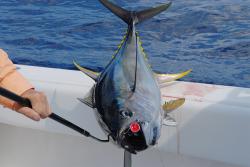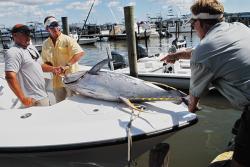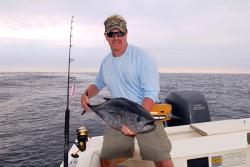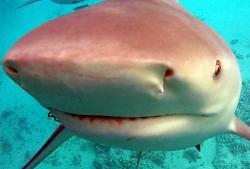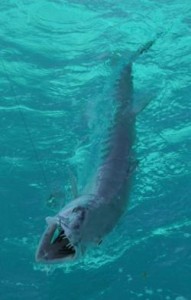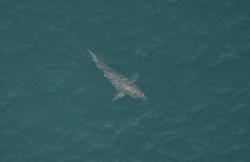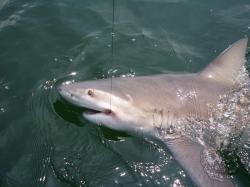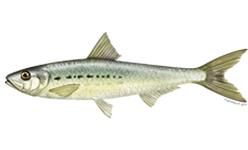Alabama’s Saltwater Fishing Doing Just Fine
By David Rainer
Alabama Department of Conservation and Natural Resources
from The Fishing Wire
Judging by the number of record fish caught in the past year and a half, it appears Alabama’s saltwater fishing is doing just fine.
Ten records were established in 2014, and five more have been established in 2015 with several months left to fish.
One of the most impressive fish that made the record book was a snowy grouper caught by Tyler Kennedy of Mobile in 2014. That fish weighed 68 pounds, 9 ounces. The world record is 70 pounds, 7 ounces.
Another record set in 2014 was a king mackerel caught by Jeremy Goldman during last year’s Alabama Deep Sea Fishing Rodeo. That fish was a dollop of fish slime away from 70 pounds. The official weight was 69 pounds, 15.84 ounces.
The cubera snapper caught by Brett Rutledge of Mobile was another impressive 2014 catch at 84 pounds, 9 ounces. Also on the big fish list was a jack crevalle caught by Joseph Condry Pope IV of Alabaster, Ala., that weighed 40 pounds, 2 ounces.Others on the 2014 record listed included a 5.0-pound Darwin’s slimehead (aka big roughy) caught by Lance Smith of Lithia Springs, Ga.; a scorpionfish caught by Ike Farmer of Salem, Ala., that weighed 4 pounds, 4 ounces; a sharksucker caught by Dylan Andrew Bauman of Spanish Fort, Ala., at 5 pounds, 13.2 ounces; a great northern tilefish caught by Dick Paul of Pensacola, Fla., at 35 pounds, 5.6 ounces; a tomtate caught by Lauren Ogle of Muncie, Ind., at 1 pound, 4.6 ounces; and a whopper of a big eye tuna caught by Bobby Abernathy of Merryville, La., at 236 pounds.
The first fish to make the record book in 2015 was a 13-pound, 9-ounce monster of a sheepshead caught by Branden Ryan Collier of Irvington, Ala.
Other fish to make the book in 2015 included a huge bull shark caught by Jeff Moore of Birmingham that weighed 448 pounds, 4 ounces; a blue angelfish caught by Natalie Parker-Beach of Fairhope, Ala., at 2 pounds, 10.6 ounces; and a cutlassfish caught by John Robert Frain of Cumming, Ga., at 3 pounds, 5 ounces. A horse-eye jack caught by Marcus Kennedy of Mobile that weighed 22 pounds, 7.2 ounces caught this July is the latest addition to the record book.
“The fact we continue to set state records in many categories, both inshore and offshore, just shows what a good fishery we have in all our waters in Alabama,” said Chris Blankenship, Director of the Alabama Marine Resources Division. “We set records on inshore species like jack crevalle and sheepshead. Then we had the offshore fish in the bigeye tuna, king mackerel and snowy grouper.”
Blankenship said that several species that made the record books in 2013 and 2014 were deep-water species that indicated somewhat of a shift away from the traditional reef-fishing activities for species like red snapper and triggerfish, both of which have limited seasons now.
“I think people were doing more deep-dropping to catch species like the tilefish,” he said. “I think people are branching out into the deep water to fish the edge of the shelf. We’re seeing some species that weren’t as popular in years past.
“But at the end of 2014 and into 2015, the record fish we’re seeing are more of the traditional species. A 13-pound sheepshead is a fine catch, and that came from just off Dauphin Island. You could see the boat ramp from where that fish was caught.”
There was also one application for record-fish status that was rejected earlier this year. An application was submitted for a yellowedge grouper, but the state record fish committee denied the application, determining the fish was a scamp, another member of the grouper family.
“The state record fish committee is made up of scientists, local fishing guides and communicators who are very knowledgeable about the fish,” Blankenship said.
When someone submits an application for a state record fish, the rules that apply are: The boat has to leave and return from an Alabama port; the fish must be weighed on certified scales and be witnessed; photos of the fish must accompany the application for verification purposes.
Another requirement is that if the species can’t be verified by the photos submitted, the fish must be kept frozen for 14 days for possible inspection.“In the particular case of the yellowedge grouper, Dr. Bob Shipp and Dr. Will Patterson felt sure it was a scamp and not a yellowedge,” Blankenship said. “The fish was not saved for inspection, so the application was denied.
“That shows the state record fish committee worked the way it was supposed to, that records are awarded to those that are deserving and meet all the criteria.”
The special red snapper season in Alabama waters for the month of July recently concluded, and Blankenship was a little surprised by the results.
“The state red snapper season was viewed very positively by the fishing community,” he said. “We didn’t have as much participation as I thought we would. But during the Alabama Deep Sea Fishing Rodeo and the Roy Martin Young Anglers Tournament, I did see a lot of red snapper weighed. It was definitely enjoyable to see people enjoying fishing in state waters during the rodeos.”
Blankenship said one theory for the lack of participation in the state red snapper season was the enforcement issue regarding the state waters limit. Alabama enforces a state waters limit of 9 miles, while federal officials enforce a 3-mile limit.
“I think some people were apprehensive about taking the risk between 3 and 9 miles,” he said. “I do think that was a big part of it. And we don’t have a huge red snapper population in state waters. The bulk of the snapper population is outside that 9-mile limit.
“But we did see some nice triggerfish catches during the state season. Although triggerfish weren’t part of our Snapper Check system, our biologists and enforcement officers saw a lot of triggerfish come in to the docks. I think the population of triggerfish has really rebounded the last couple of years. With the federal management of triggerfish, it has kept down people’s access to that fishery as it rebuilds. The federal system takes a couple of years to catch up with what’s being seen on the water. The population of triggerfish offshore and in state waters has really picked up.”
Amberjack season re-opened on August 1, which gives anglers one of the more popular species to catch while red snapper season is closed.
“Here at Marine Resources, we’re trying to build reefs that are more productive for species like amberjack,” Blankenship said. “We put 25-foot-tall pyramids down two years ago. We sunk a 70-foot boat off Dauphin Island. We sunk a rig as part of the Rigs to Reefs program south of Dauphin Island. We’re increasing habitat for species other than red snapper. We’ve built some great habitat for amberjack so our fishermen will have opportunities to fish for other species while red snapper and triggerfish are closed.”
PHOTOS: No strangers to the Alabama saltwater record book, the father-son duo of Tyler and Marcus Kennedy have two entries each on the list. Tyler’s latest entry is a 68-pound, 7-ounce snowy grouper, while dad, Marcus, added a horse-eye jack that weighed 22 pounds, 7.2 ounces.


